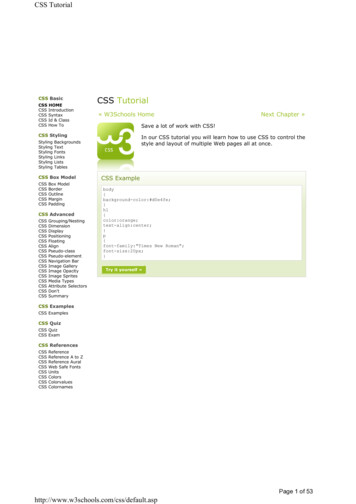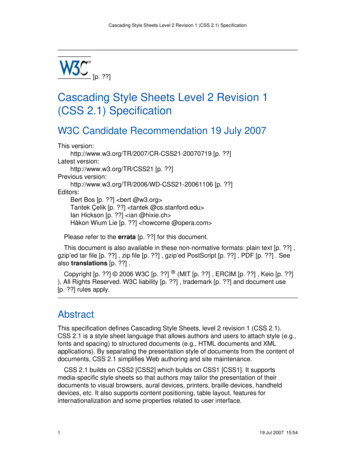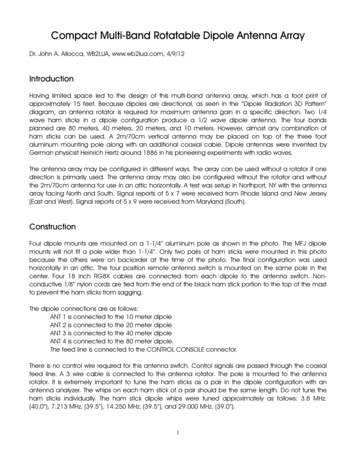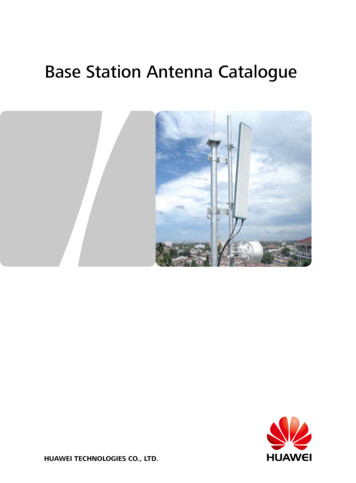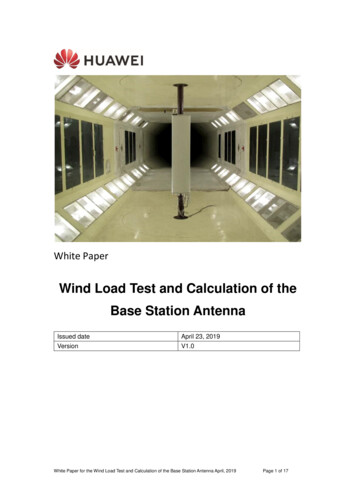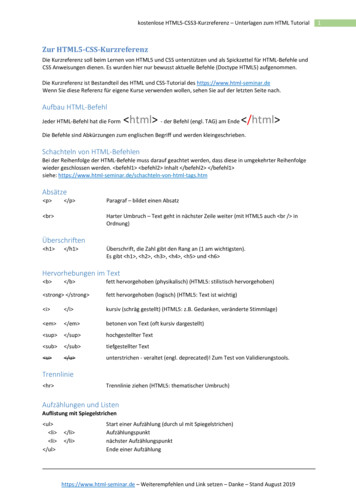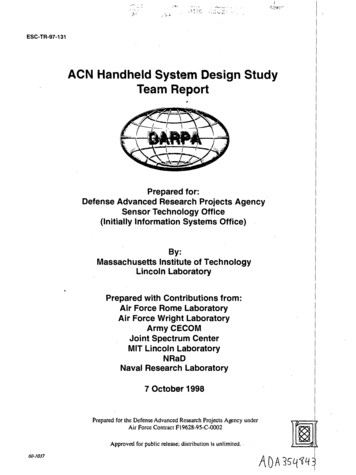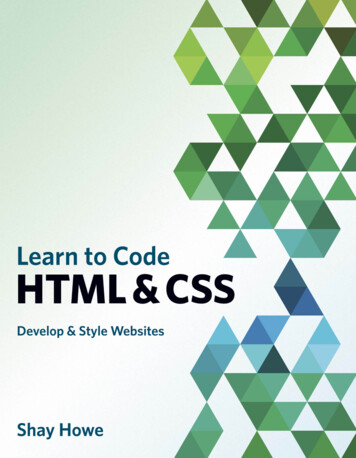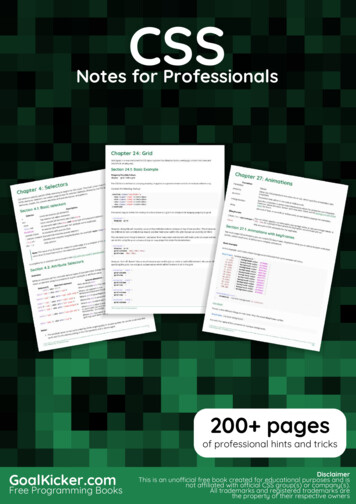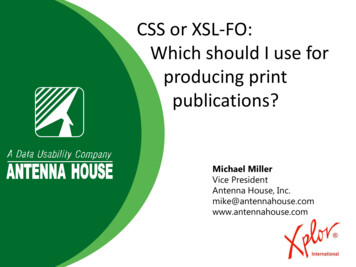
Transcription
CSS or XSL-FO:Which should I use forproducing printpublications?Michael MillerVice PresidentAntenna House, Inc.mike@antennahouse.comwww.antennahouse.com
Is This A Marketing Talk?
Every Technical Detail?
Pages, Print& Paper
CSS and XSL-FO Cascading Style Sheets (CSS)– Used mainly for the web, is a style sheet language to describe thepresentation (that is, the look and formatting) of a document written inHTML, XHTML and XML. CSS can now also produce paged output. Extensible Stylesheet Formatting Objects (XSL-FO)– Used for print, is a pagination markup language describing a renderingvocabulary capturing the semantics of formatting information forpaginated presentation.– Both from W3C
“Once is Enough” Separation of content from form Integrated database – text, graphics, etc. Information is captured once Information is stored once
The ChallengeCharles Darwin (1809-1882)Our focus here is the printed/PDF document
Alphabet Soup for documents and print
Markup CSSXSL-FOtroffTeXLaTexHTMLHTML5XMLSGMLXHTML
Page Description AFPHP-GLPDLPostScriptMODCAPDFXPS
Schemas/DTD/Data Model DITA (Darwin Information Typing Architecture) – some ofthe uses include software, product, and trainingdocumentation. DocBook – format for technical (but not only) manuals anddocumentation. S1000D – international specification for technicaldocumentation related to commercial or military; aerospace,sea or land; vehicles or equipment. JATS (Journal Article Tag Suite) – a NISO standard of XMLused to describe and publish STEM(scientific/technical/engineering/medical) scholarly journalarticles. Text Encoding Initiative (TEI) – Guidelines for text encodingin the humanities, social sciences and linguistics.
Challenges Typesetting, page and document layout is a complex craft that drawfrom a wide variety of disciplines including art, technology,psychology, etc. It has always been difficult to produce high quality print outputfrom XML and SGML Historically, this has required a significant financial investment inspecialized typesetting tools, (e.g. Advent 3B2, DatalogicsPager/Composer, Miles 33, Arbortext Publisher, Xyvision XPP, TeX,etc.) These tools have a steep learning curve due to often cryptic,proprietary stylesheet languages or typesetting codes Each of the specialized typesetting tools uses its own markup
The Anatomy ofPrinted PublicationsFront Matter- Title page- Table of contents- List of figuresBodyBack Matter- Chapters- Index Tables Graphics- Appendices Paragraphs
For Formatting You Need portrait and landscape pages generated ToCs recto-verso pages generated page numbering multiple page sizes graphics multiple writing directions re-sorting items for output Unicode tables headers/footers widow/orphan control floating area hyphenation and justification multiple columns change bars
The Driving Forces Controlling costsMultilingual documentsMore pages and more publications than ever beforeWorking in a global communityIntegrating multiple sources of contentUsing information as a competitive advantage Standards Technology
How do you know you need it?If your INFORMATION is If your PROCESS has Revised betweenproduction cycles Re-used in different ways Published and delivered indifferent formats Boilerplates gets updatedwith customizedinformation Multiple authors andreviewers Multiple departmentsinvolved Local and remote documentcreation Local and remotedistributions External deadlines
Motivation: The Business Case forXML, CSS and XSL-FOWhat you want: High quality, consistent output “look and feel”, “branding” Automated production of informationproducts Reduced cost, rapid dissemination Supports re-purposing of content “single-source publishing” Supports the investment in contentrather than presentation “separation of content fromformatting” Independent of any particularapplication “portability” Availability of resources “non-proprietary skills, languages”
When to Use CSS or XSL-FOHigh Need Technical DocumentationUser ManualsTraining e ListInsurance PoliciesLegal ContractsStatements and InvoicesStructured Content/Data toStructured LayoutsLow Need PresentationsNewslettersFlyersDisplay AdsOne-Time BrochuresChanging designTextbooksContent/Data toUnstructured Layouts
Content to Web & Print/PDF TraditionalXMLXHTMLCSSXSL-FO
XSL-FO(Extensible Stylesheet Formatting Objects)This is the part of XSL that deals withhow structured information should bepresented in print.
XSLT XSLT (Extensible Stylesheet LanguageTransformations) is a language fortransforming XML documents into otherXML documents, or other formats such asHTML for web pages, plain text or XSLFormatting Objects, which maysubsequently be converted to otherformats, such as PDF, PostScript and PNG.
XSLT can transform XML documents into XSL-FO– Sort lists within documents– Replace text– Generate back of book indexesCSS does not use XSLT– But it can
Typical publishing data flowshttps://www.w3.org/Style/CSS-vs-XSL.en.html
What is Documented with XSL-FO
Documents Formatted with XSL-FO
Current Document Formatting for Print PDF through XSL-FO– Antenna House XSL Formatter– Apache FOP– RenderX XEP Other options– Framemaker– InDesign
From the beginning CSS– Cascading Style Sheets– W3C Recommendation– OriginallyWouldn’t it be nice if you could also use CSSfor print?CSS3 adds page layout functionality for print Simple mechanism for adding style (fonts, color, spacing to webdocuments– Now Mechanism for both web and print documents CSS 3 – CSS Generated Content for Paged Media Module WorkingDraft May 2014
What is CSS3 Web functionality – CSS3 Module: Paged Media– CSS3 module: Generated Content for PagedMedia
So Why CSS3?CSS3 is an acknowledgement thatCSS also needs to address pageformatting.
The “Cascading” Stylesheet CSS can have up to 3 levels of styleinformation:– The default style– Style specified in a separate stylesheet– Style specified in the actual document or data
Examples of CSS3 within a stylesheetPage setting @page rule@page {size: A4;margin: 25mm;@top-center {content: "Sample";}@bottom-center {content: counter(page);}}@page {size: 4in 6in;}@page {size: letter landscape;}
CSS3 Module: Paged Media adds Running headers and med flowsHyphenationNew counter stylesCharacter substitutionImage resolutionPage floats Advanced multi-column layoutConditional contentCrop and cross marksBookmarksCMYK colorsContinuation markersChange barsLine numbersNamed page listsGenerated lists– TOC– Glossary– Index
Page Boxes: the @page Rule – Page Terminology and thePage Model– Page types– Page size– Page Selectors and the PageContext– Page Properties– Left, right, and first pages– Content outside the page box Margin Boxes– At-rules for margin boxes– Maximum Dimension ofmargin boxes– Dimension of margin boxes– Margin boxes and defaultvalues Margin box examples– Populating margin boxesPage Breaks– Break before/after elements:'page-break-before', 'pagebreak-after', 'page-breakinside‘– Using named pages: 'page‘– Breaks inside elements:'orphans', 'widows‘– Allowed page breaks– Forced page breaks– "Best" page breaks Page-based Extensions toCounters– Page-based counters Orienting an Image on the PageThe 'fit' and 'fit-position'Properties
Documents Formatted with CSS
Content to Web & Print/PDF With CSSDITAXMLXHTMLCSS
CSS Options Antenna House CSS FormatterPrince XMLPDFreactorPagination.jsSimplepagination.js
Now there is a choice!CSS or XSL-FO
Why Two Stylesheet Languages? W3C originally viewed print and web as two distinctfunction, XSL-FO for print and CSS for web XSL-FO is over 20 years old Thousands of implementations based on XSL-FO A large number of available Stylesheets for XSL-FO DITA, DocBook, JATS, S1000D A reasonable open source implementation for XSL-FO CSS paged media is relatively new by comparison The CSS products that support paged output are nowbecoming available Awareness of CSS for paged media is increasing
CSSXSL-FOCan be used with HTML?YesNoCan be used with XML?YesYesTransform language?NoYesSyntaxCSSXML
Spread produced with XSL-FO
Spread produced with XHTML CSS
XSL-FO to CSS: Headers & FootersCSSXSL-FO
XSL-FO fo:layout-master-set fo:layout-master-set fo:simple-page-master master-name "left” . /fo:simple-page-master fo:simple-page-master master-name "right" . /fo:simple-page-master fo:page-sequence-master master-name "psm" fo:repeatable-page-master-alternatives ce "left"odd-or-even "even"/ ce "right"odd-or-even "odd"/ /fo:repeatable-page-master-alternatives /fo:page-sequence-master /fo:layout-master-set
CSS @page rule@page {size: 120mm 140mm;@footnote {float: bottom page;width: 100%;}}@page :right {@bottom-right {content: counter(page) " of " counter(pages);}}@page :left {@bottom-left {content: counter(page) " of " counter(pages);}}
XSL-FO and CSS overlap in capabilitiesCSS 3XSL-FO
Extensions Extensions add features that are not part of the corespecification.XSL-FO/CSSaxf:crop-offset / ah-crop-offsetaxf:crop-offset-top / ah-crop-offset-topaxf:crop-offset-bottom / ah-crop-offset-bottomaxf:crop-offset-left / ah-crop-offset-leftaxf:crop-offset-right / ah-crop-offset-right
XSL-FO and CSS overlap in capabilities ExtensionsCSS 3XSL-FO
XSL-FO and CSS overlap ExtensionsCSS 3FormattingXSL-FOSoftware
‘axf:’ prefix ‘-ah-’ prefixAH Formatter Extension‘axf:’ prefix CSS specificationCSS in XSL-FOXSL section no. ‘-ah-’ prefixXSL-FO in CSS
Organizations can optimize the creation and publishing ofdocumentation to address business requirements Pressures Actions Capabilities o Shorter documentation development scheduleso Publish in multiple delivery formats (paper, electronic and web)o Provide real time customization at the point of interactionooooSingle source authoring of documentationAutomated publication of documentation through captured logicLocalizationGraphicsooooStandardsStructured authoring applicationsContent management systemsIntegration of structured authoring application and content management systemsEnablersCSS3 and XSL-FO can be an important component of this!!
The benefits of a standardized format for data andpresentation are overwhelming. They include: Complete interoperability of both content and style across applicationsand platformsFreedom of content creators from vendor control of production toolsFreedom of users to choose their own views into contentEasy construction of powerful tools for manipulating content on a largescaleMultiple products and multiple vendors to choose fromEasily integrates with other standards compliant applicationstrue international publishing across all media
Standards!For formatting you now have two standardsto choose from:CSS and XSL-FO
Pagination for StructuredDocuments can be completelyautomated!
Benefits of CSS and XSL-FOas Part of an Implementation Reduce the cost of technology investment Enable vendors to compete and provide standards-basedsolutions Create efficiency by reducing duplicate processes Reduce vendor or IT support Eliminate data transformation between different specifications Overall cost savings with respect to system maintenance,upgrade, training, etc. Enable the use of the same authoring and publishing solutionfor both web and paper
CSS or XSL-FOXSL-FONow over 20 years oldCan do complex document formattingMuch more effort went into developing XSL-FOMore resources availableo Stylesheets available for DITA, DOCBook, S1000D, JATS,o Product – Commercial and Open Source CSS3 Now over 13 years oldCan do almost all the same level of complex document formattingEasier to use and easier to learn easier to maintain and cheaperCSS simplicity means it has its limitations
CSS or XSL-FOUse CSS or XSL-FO when you can A lots of resources Large community of users Thousands of implementations Integrated with a large number of systems Available for almost all operating systems, cloud,and virtual machines
Questions?Michael MillerVice PresidentAntenna House, Inc.mike@antennahouse.comwww.antennahouse.com
CSS or XSL-FO: Which should I use forproducing print publications? Michael MillerAntenna House 1 com58
CSS and XSL-FO Cascading Style Sheets (CSS) –Used mainly for the web, is a style sheet language to describe the presentation (that is, the look and formatting) of a document written in HTML, XHTML and XML
